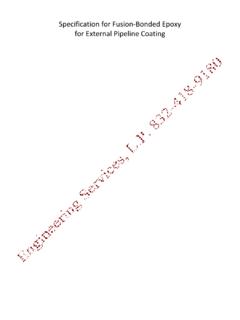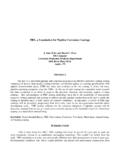Transcription of Fusion Bonded EpoxyNACE - Polyguard
1 Fusion Bonded epoxy A Field Proven Fail Safe Coating System By Richard Norsworthy TEPSCO, L. P. 501 South Bluegrove Road Lancaster, TX 214-912-0972 ABSTRACT After forty years of use, many end users do not recognize one very important benefit of Fusion Bonded epoxy (FBE) pipeline coating it is Fail Safe . As with all pipeline coatings, FBE coatings have failed while in service, but rarely is there corrosion on the pipe under the failed coating. When adequate cathodic protection is available, FBE is Fail Safe because it does not shield CP current when disbondment occurs. Those who are responsible for selecting pipeline coatings should consider the use of Fail Safe coatings, so that when the coating fails, the pipe will be protected by the CP. Key Words Fail Safe; Fusion Bonded epoxy ; FBE; cathodic protection; cathodic protection shielding; disbondment; pipeline coating; blistering.
2 Introduction Fusion Bond epoxy (FBE) coatings offer the end user with a pipeline coating that will allow (adequate) cathodic protection to actually protect the pipe steel under any failed or disbonded coating. This is a Fail Safe pipeline coating system. A Fail Safe coating system is defined as one that will allow cathodic protection (CP) current to pass through it to protect the substrate not shield CP should the coating bond fail and adequate CP is This is not a 100% claim, but this phenomenon has been witnessed and documented on many in-service pipelines coated with FBE. When FBE fails, corrosion is rarely present under the failed FBE when adequate CP is available. There are many parameters that must be considered when selecting pipeline coating systems. One of the parameters many engineers fail to include in the coating selection criteria, is What will happen if and when the coating fails?
3 A key consideration should be Will the coating shield CP if the bond fails? 2 However, all coatings experience some disbondment and, therefore, the behavior of a disbonded coating is important in the overall performance of a coating Even with adequate cathodic protection (CP), corrosion can occur under most disbonded With adequate CP, Fusion Bonded epoxies (FBE) do not totally shield CP currents5; therefore corrosion is not a major problem. Another very important factor about FBE pipeline coatings is that stress corrosion cracking (SCC) has never been found under disbonded FBE coatings. It is believed that the high permeability of FBE coating to water is the reason for the apparently transparent nature of FBE coating to the cathodic Stress corrosion cracking has been studied extensively and has never been observed on FBE coated pipelines in over thirty So the Fail Safe properties of allowing CP current and creating a high pH also extend to help prevent SCC on pipelines coated with FBE.
4 FAILURE MODES OF COATINGS All coatings can and will fail. There are many reasons why a coating fails. These failure modes have been well documented 3,4,6,7,8,9,10,11 so they will be briefly discussed in this paper. Surface Preparations Improper surface preparation is the reason for most coating failures. Contaminants, such as ionic salts will mix with water to cause disbondment and blistering. Hydrocarbons will not allow proper adhesion. FBE requires a well prepared and clean surface (near white) with a profile of to mils of anchor pattern. Application Techniques Application processes can be a critical problem for all pipeline coatings. Application temperature is the most critical for the proper application of FBE. Soil Stress Soil stress can damage many types of coating systems as documented in many articles. When the coating strength is less than the stresses introduced by the soil, the coating will FBE is rarely affected by soil stress, but most other coating systems can be damaged easily by soil stress.
5 Selection Criterion Many times coatings are selected for reasons that do not take into account all the possible failure modes and the resulting consequences when they do fail. All coatings will and do fail. All coatings have openings, pinholes, micro-fissures and other methods of allowing water, oxygen and other corrosion causing compounds to migrate through at different rates. FBE for example allows some water to penetrate as mentioned in the book Fusion - Bonded epoxy (FBE) by J. Alan Kehr. However, FBE maintains its insulating properties in the presences of moisture and cathodic protection Operating Temperature Operating temperature is always a critical factor in choosing a proper coating system. Many coatings, including FBE, are affected by the operating temperature of the pipeline. Higher or lower than specified temperatures can cause coatings to deteriorate, crack, lose adhesion or gravity flow of the coating on the pipe.
6 Higher and lower temperature FBE coatings have been developed. The higher the operating temperature the more rapidly water will penetrate. There are many other parameters that affect the performance of a pipeline coating, but these are some of the more critical ones. We must consider all the factors for each particular exposure and service when choosing a coating type. TYPICAL FBE FAILURE MODES FBE can fail like any other coating. Though coating manufacturers do not admit their particular coatings will fail, those of us in industry know better. In most cases the failure is not the fault of the coating or its formulation, but of the application techniques, selection criteria, or surface preparation. Cathodic Disbondment and Blistering Cathodic protection can affect all coatings. The alkaline conditions that develop at the cathode will deteriorate some types of coatings and cause others to disbond.
7 Formation of hydrogen and hydrogen evolution has been debated and studied as another possible cause of coating disbondment. Laboratory tests indicate that the presence of hydrogen bubbles plays little or no role in the rate of Various ON or polarized potentials have been used through the years by different companies in an effort to establish a potential at which to operate their CP system when using FBE. This author has been involved in FBE systems that operate at ON potentials more negative than -6 volts for several years with no detrimental affects to the FBE. Other systems have blistering or failed at ON potentials of volt or less negative. This seems to point to the fact that many of the FBE failures are related to causes other than over voltage. CP will cause the water to penetrate more rapidly. The water that penetrates is relatively pure, but will mix with surface salts to cause blistering if the areas of contamination are small.
8 Larger areas of contamination may cause the FBE to fail in large, disbonded sheets. Pinholes or holidays may be present but are not necessary for this disbondment to occur because the water penetrates through the coating. Blistering of FBE will occur when water penetrates and combines with the surface salts to cause the disbondment and the subsequent blistering. Blistering from cathodic protection is the result of the alkaline environment that develops at the cathode. Areas where the wetting out of the surface by the coating was not sufficient or contaminants were present leave small areas of little or no adhesion. These become areas where water can be reduced. As water migrates to these areas, electron transfer takes place creating hydroxyl ions, starting the blistering process. Loss of Adhesion FBE has the best overall adhesion of any pipeline coating system when properly applied. If large areas of adhesion failure occur, the cause may be inadequate profile, large areas of surface contamination or application temperature problems.
9 Excessive Holidays Excessive holidays are commonly caused from overheating heating during the application process, slivers in the pipe steel, contaminants on the pipe or in the coating material, or mishandling during the coating process or construction. The coating applicator has the responsibility of checking for and repairing holidays during the coating inspection process at the plant. The contractor has the responsibility of inspecting for and repairing holidays during construction. If holidays are found during dig inspections, the cause for the holidays will typically be backfill related. Of course, if these were not properly inspected or repaired they could be from the problems mentioned above. The blistering mentioned above could also have pin holes or holidays develop during the blistering process. The holiday was not necessarily present before the blistering occurred. Excessive Operating Temperature If the operating temperature of the FBE is exceeded, then the coating can deteriorate.
10 The FBE may become soft or grainy and can be easily removed with a knife, etc. Fusion Bonded epoxy (FBE) coatings can absorb more water than normal at higher temperatures, but do not flow or move on the Glass transition temperatures can be exceeded however changes in physical properties can be expected, may not change the long term performance. Chalking and Disbondment Polymer degradation (chalking) from ultra-violet exposure will cause FBE to be grainy in appearance and surface chalking of 2 to 3 mils can be easily removed. There is a discoloration and change in appearance. This damage will typically be a few mils of thickness. If FBE coated pipe is stored where sunlight and air borne elements such as dust, rain, snow and other air borne pollutants contact the coated pipe, FBE is damaged, leading to failure of the coating. For this reason, if FBE is stored, it should be protected from the elements as much as possible.










